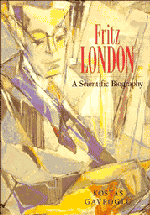Book contents
- Frontmatter
- Contents
- Preface
- Acknowledgements
- 1 From philosophy to physics
- 2 The years in Berlin and the beginnings of quantum chemistry
- 3 Oxford and superconductivity
- 4 Paris and superfluidity
- 5 Tying up loose ends: London in the USA
- Afterword: background leading to the microscopic theory of superconductivity by John Bardeen
- Publications by Fritz London
- Bibliography
- Index
Afterword: background leading to the microscopic theory of superconductivity by John Bardeen
Published online by Cambridge University Press: 12 January 2010
- Frontmatter
- Contents
- Preface
- Acknowledgements
- 1 From philosophy to physics
- 2 The years in Berlin and the beginnings of quantum chemistry
- 3 Oxford and superconductivity
- 4 Paris and superfluidity
- 5 Tying up loose ends: London in the USA
- Afterword: background leading to the microscopic theory of superconductivity by John Bardeen
- Publications by Fritz London
- Bibliography
- Index
Summary
It took almost half a century after the discovery of superconductivity by Kamerlingh Onnes in 1911 before a satisfactory explanation at the microscopic level was given by Robert Schrieffer, Leon Cooper and me in 1957. The theory was the result of many years of effort by many people in both theory and experiment. The first theories were phenomenological: equations were proposed to account for a range of experiments without an understanding of how they could be derived from the equations of motion of the electrons and ions that constitute a superconducting metal.
By far the most important step towards understanding the phenomena was the recognition by Fritz London that both superconductors and superfluid helium are macroscopic quantum systems. Quantum theory was derived to account for the properties of atoms and molecules at the microscopic level. It was Fritz London who first recognized that superconductivity and superfluid flow result from manifestations of quantum phenomena on the scale of large objects.
Perhaps the most striking illustration is that the magnetic flux threading a superconducting ring is an integral multiple of a small flux unit, hc/2e. In a footnote in his book published in 1950, London predicted such a relation (with e rather than 2e in the denominator). Flux quantization was first observed experimentally eleven years later. Quantization is a direct result of the de Broglie relation between momentum and wave length, p = h/λ, and the fact that there must be an integral number of wave lengths around the ring, nλ = 2πr, where r is the radius.
- Type
- Chapter
- Information
- Fritz LondonA Scientific Biography, pp. 267 - 272Publisher: Cambridge University PressPrint publication year: 1995
- 1
- Cited by



